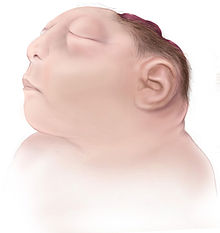| Anencephaly | |
|---|---|
 | |
| Illustration of an anencephalic fetus | |
| Specialty | Medical genetics; pediatrics |
| Symptoms | Absence of the cerebrum and cerebellum |
| Risk factors | Folic acid deficiency |
| Prevention | Mother taking enough folic acid |
| Prognosis | Death typically occurs within hours to days after birth |
| Frequency | 1 in 4600 in the U.S. |
Anencephaly is the absence of a major portion of the brain, skull, and scalp that occurs during embryonic development.[1] It is a cephalic disorder that results from a neural tube defect that occurs when the rostral (head) end of the neural tube fails to close, usually between the 23rd and 26th day following conception.[2] Strictly speaking, the Greek term translates as "without a brain" (or totally lacking the inside part of the head), but it is accepted that children born with this disorder usually only lack a telencephalon,[3] the largest part of the brain consisting mainly of the cerebral hemispheres, including the neocortex, which is responsible for cognition. The remaining structure is usually covered only by a thin layer of membrane—skin, bone, meninges, etc., are all lacking.[4] With very few exceptions,[5] infants with this disorder do not survive longer than a few hours or days after birth.
- ^ "Cephalic disorders – Overview, Anencephaly, Colpocephaly – neurologychannel". September 3, 2015. Archived from the original on May 9, 2008. Retrieved September 19, 2016.
- ^ O'Rahilly, M; Muller, F (1992). Human Embryology & Teratology. New York: Wiley-Liss, Inc. p. 253. ISBN 978-0471382256.
- ^ Chervenak, F.A.; Kurjak, A.; Comstock, C.H. (1995). Ultrasound and the Fetal Brain: Progress in Obstetric and Gynecological Sonography Series (1st publ ed.). New York: Parthenon Pub. Group. p. 102. ISBN 978-1850706120.
- ^ "Anencephaly Information Page: National Institute of Neurological Disorders and Stroke (NINDS)". Archived from the original on 2 December 2016. Retrieved 2016-12-02.
- ^ "Baby Without A Brain, Nickolas Coke, Update". Archived from the original on 2012-09-14.